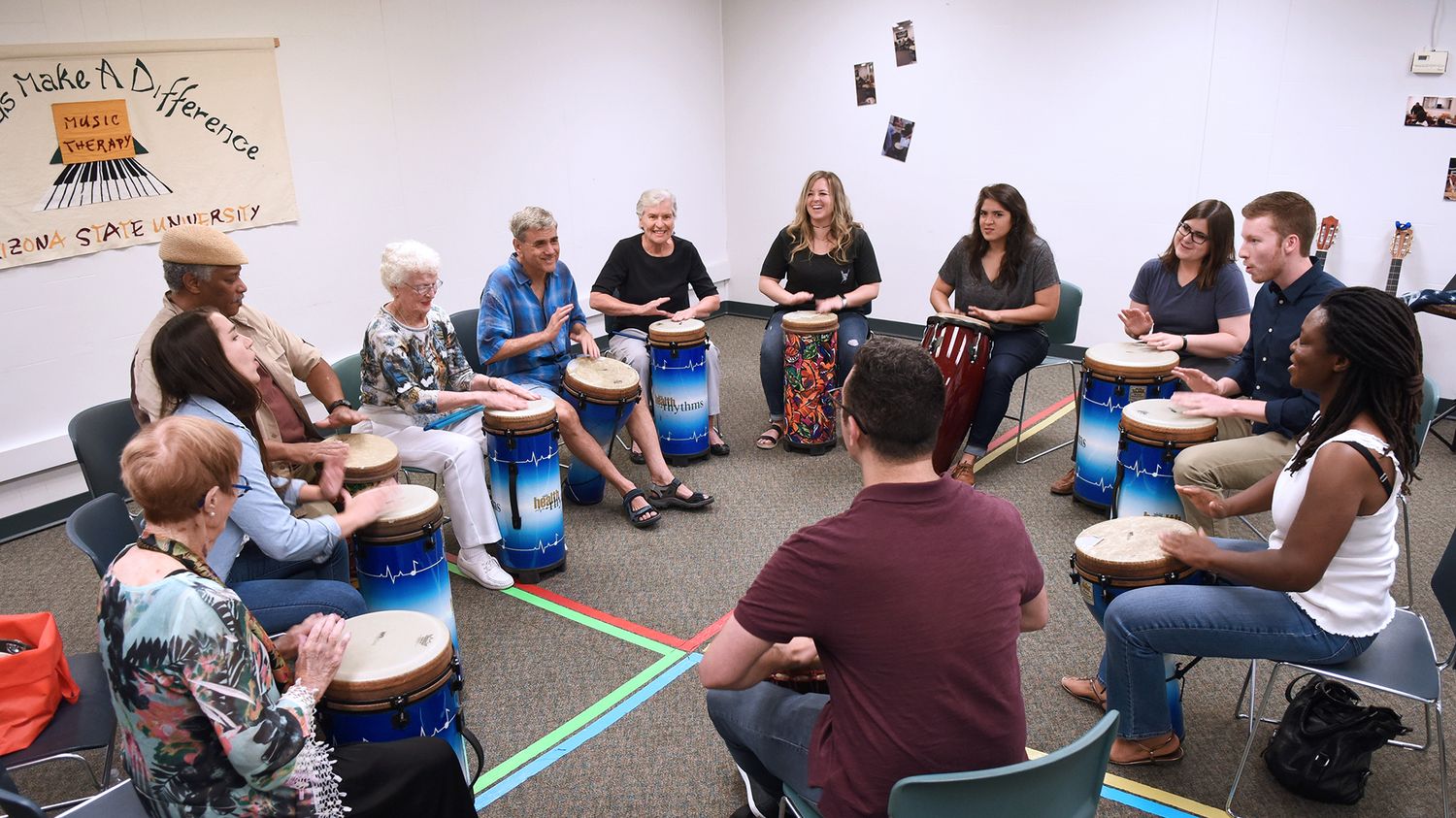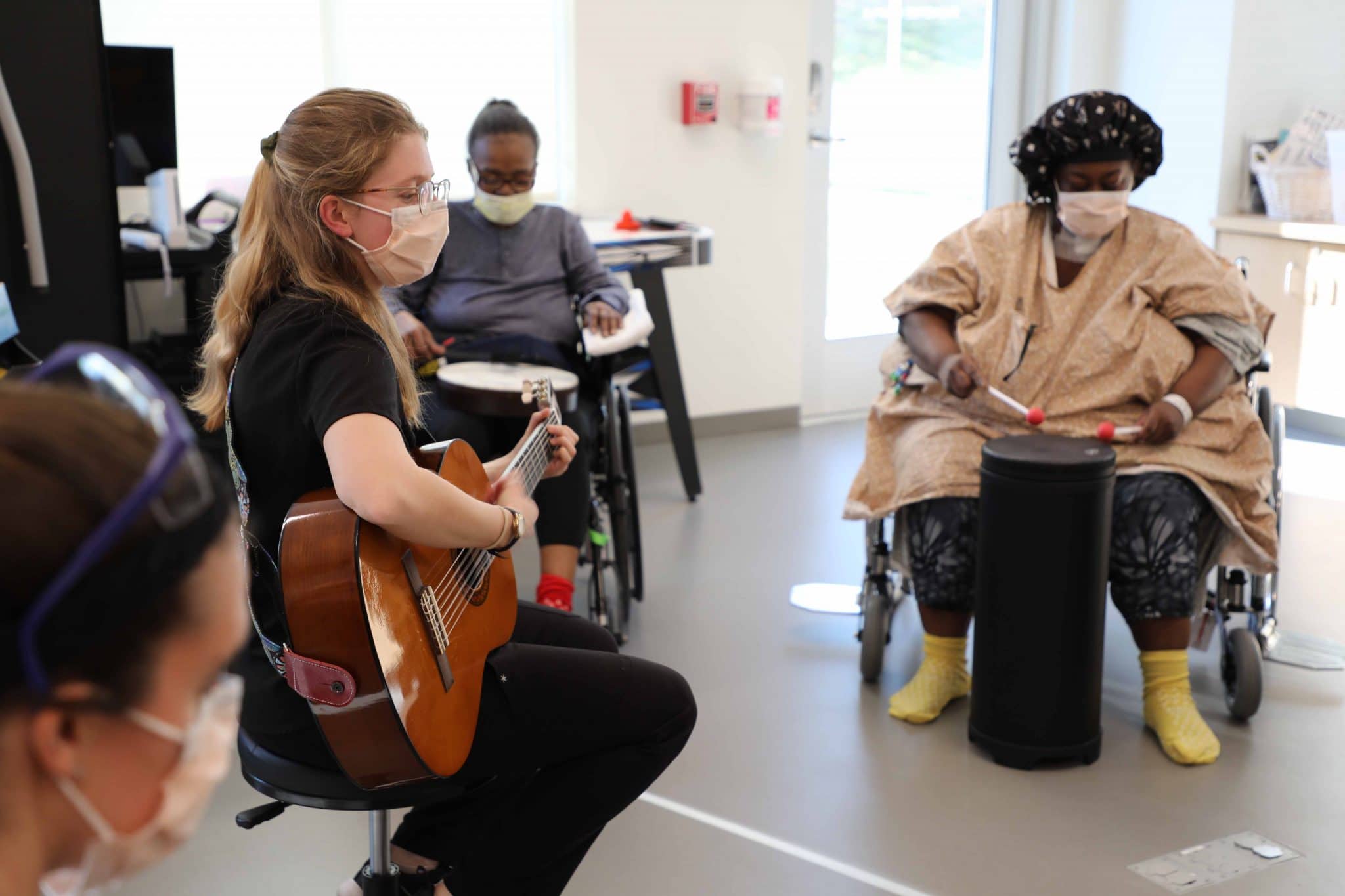Home>Events & Info>Music Therapy>What Do You Do In A Music Therapy Session


Music Therapy
What Do You Do In A Music Therapy Session
Modified: February 7, 2024
Experience the power of music therapy in our sessions. Discover how music can heal and transform, as our expert therapists guide you on a journey towards emotional and mental well-being.
(Many of the links in this article redirect to a specific reviewed product. Your purchase of these products through affiliate links helps to generate commission for AudioLover.com, at no extra cost. Learn more)
Table of Contents
- Introduction
- Understanding Music Therapy
- Benefits of Music Therapy
- The Role of a Music Therapist
- What to Expect in a Music Therapy Session
- Assessing Individual Needs in Music Therapy
- Music Therapy Techniques and Activities
- Promoting Emotional Expression and Communication through Music
- Using Music to Enhance Cognitive Skills and Memory
- Improving Physical and Motor Skills with Music Therapy
- Addressing Mental Health and Well-being through Music
- Group Music Therapy Sessions
- Adapting Music Therapy for Different Populations
- Conclusion
Introduction
Welcome to the world of music therapy! In this article, we will explore the fascinating field of music therapy and the many benefits it offers. Music therapy is an evidence-based practice that utilizes music to address physical, emotional, cognitive, and social needs of individuals. It is a unique and powerful therapeutic approach that can have a profound impact on people’s lives.
Music has long been recognized for its ability to evoke emotions and create a connection between individuals. In music therapy, trained professionals combine the power of music with therapeutic techniques to facilitate healing and growth. Whether it’s playing instruments, singing, or listening to music, each musical experience is carefully crafted to meet the needs and goals of the individual.
Music therapy is not just about listening to music or playing instruments for pleasure. It is a structured and intentional process that is tailored to each individual’s specific needs. The therapist assesses the client’s abilities, preferences, and goals to develop a personalized treatment plan. The therapeutic relationship that develops between the therapist and the client is essential for creating a safe and supportive environment for healing.
Throughout this article, we will delve into the benefits of music therapy, the role of a music therapist, and what to expect in a music therapy session. We’ll explore various techniques and activities used in music therapy, and how they can promote emotional expression, enhance cognitive skills, improve physical and motor skills, and address mental health and well-being. We’ll also discuss the different populations that can benefit from music therapy and highlight the adaptations made for each group.
So, whether you’re curious about music therapy as a potential career path, interested in receiving music therapy yourself, or simply want to learn more about this incredible therapeutic modality, read on to discover the wonders of music therapy!
Understanding Music Therapy
Music therapy is a specialized field that integrates the power of music with therapeutic techniques to address a wide range of physical, emotional, and cognitive needs. It is an evidence-based practice that has been proven effective in various clinical and non-clinical settings.
At its core, music therapy recognizes the profound impact that music can have on our emotions, memories, and overall well-being. When used in a therapeutic context, music becomes a tool for communication, expression, and healing. The therapist uses music as a medium to connect with individuals, facilitate self-awareness, and promote positive change.
Music therapy is a holistic approach that takes into account the individual’s unique needs, preferences, and abilities. It can be used with people of all ages, from infants to older adults, and can benefit individuals with a wide range of conditions, including but not limited to autism spectrum disorder, depression, anxiety, Alzheimer’s disease, traumatic brain injury, and physical disabilities.
In a music therapy session, the therapist utilizes various music-based activities and techniques to achieve therapeutic goals. These can include playing instruments, singing, songwriting, music improvisation, active listening, and even movement to music. The therapist may also incorporate other modalities such as guided imagery, relaxation techniques, and verbal processing to enhance the therapeutic experience.
One of the key principles of music therapy is the use of live music. Unlike simply listening to pre-recorded music, engaging in live music-making with a trained therapist allows for moments of spontaneity, improvisation, and individualized response. This live interaction creates opportunities for exploration, expression, and connection with oneself and others.
It is important to note that music therapy is not about becoming a professional musician or achieving a certain level of musical skill. The focus is on the therapeutic process itself, rather than the musical product. The therapist’s role is not to judge or critique the individual’s musical abilities, but rather to create a supportive environment where the individual can freely express themselves through music.
Overall, music therapy offers a unique and dynamic approach to healing and personal growth. It harnesses the power of music to create positive change in individuals, promoting physical, emotional, cognitive, and social well-being. As we delve deeper into the world of music therapy, you will discover the specific benefits it can offer and the techniques used to achieve them.
Benefits of Music Therapy
Music therapy offers a multitude of benefits for individuals across all age groups and a variety of conditions. Through the use of music, it can have a positive and transformative impact on physical, emotional, cognitive, and social well-being. Let’s explore some of the key benefits that music therapy can provide:
- Emotional expression and regulation: Music has the power to evoke and elicit emotions in a unique and powerful way. In music therapy, individuals can express their emotions through playing instruments, singing, or listening to music, even when words may be difficult to find. This can lead to a greater sense of self-awareness, emotional release, and improved emotional regulation.
- Stress reduction and relaxation: Music has been shown to reduce stress and induce relaxation responses in the body. Slow and calming music can lower heart rate, blood pressure, and cortisol levels, promoting a sense of calm and well-being. This can be particularly beneficial for individuals dealing with anxiety, depression, or chronic pain.
- Cognitive enhancement: Music engages various cognitive processes, such as attention, memory, and executive functioning. In music therapy, stimulating activities like rhythmic exercises, pattern recognition, and songwriting can help improve cognitive skills, memory, and overall cognitive functioning. It can be especially effective in individuals with neurodevelopmental disorders or cognitive impairments.
- Physical rehabilitation: Music therapy can be used as a motivating and engaging tool in physical rehabilitation. The rhythmic and melodic elements of music can support movement and coordination exercises, helping to improve motor skills, strength, and balance. It can benefit individuals recovering from stroke, traumatic brain injury, or physical disabilities.
- Social interaction and connection: Music has a universal quality that can bring people together and facilitate social connection. In group music therapy sessions, individuals have opportunities to engage in musical activities together, foster communication, and develop social skills. This can be particularly valuable for individuals with autism spectrum disorder, social anxiety, or isolation.
- Enhanced mood and well-being: Music has the ability to uplift and improve mood. Listening to uplifting music or engaging in music-making activities can release endorphins and dopamine, promoting positive feelings and a sense of well-being. It can be a powerful tool for boosting mood and combating symptoms of depression and other mood disorders.
These are just a few examples of the benefits that music therapy can offer. Each individual’s experience with music therapy is unique, and the specific benefits may vary based on their needs and goals. The trained music therapist assesses the individual’s needs and tailors the therapy accordingly to maximize the positive outcomes. As we explore further, we will delve into the role of the music therapist and the techniques used in music therapy sessions.
The Role of a Music Therapist
A music therapist is a trained professional who uses music as a therapeutic tool to address the physical, emotional, cognitive, and social needs of individuals. They have a deep understanding of the therapeutic benefits of music and are skilled in creating and implementing tailored interventions to meet the unique goals and needs of each client.
The key role of a music therapist is to build a strong therapeutic relationship with the individuals they work with. They create a safe and supportive environment where individuals can freely express themselves through music and feel heard and understood. The therapist fosters trust and mutual respect, creating a space where individuals can explore and process their thoughts, emotions, and experiences.
Music therapists are not only proficient in a wide range of musical skills, but they also possess a solid foundation in psychology, sociology, and human development. This enables them to understand the complexities of human behavior and development and apply that knowledge in a therapeutic context.
When working with clients, music therapists conduct thorough assessments to understand their strengths, needs, and goals. They consider the individual’s musical preferences, abilities, and cultural background to develop a personalized treatment plan. The treatment plan may include a variety of music-based activities such as playing instruments, singing, songwriting, music improvisation, and active listening.
During the therapy sessions, the music therapist observes and analyzes the individual’s responses to the music and adjusts the interventions accordingly. They offer support and guidance, encouraging individuals to explore their emotions, develop coping strategies, and work towards their therapeutic goals.
Furthermore, music therapists collaborate with other healthcare professionals, educators, and caregivers to ensure a holistic approach to treatment. They communicate regularly to provide updates on progress and discuss strategies for continued support outside of therapy sessions. Music therapists also educate and advocate for the benefits of music therapy, promoting awareness and understanding of this powerful modality.
It’s important to note that music therapists do not aim to turn individuals into professional musicians or achieve specific musical outcomes. Rather, they use music as a tool to facilitate personal growth, self-expression, and healing. The focus is on the process and the therapeutic benefits that can be derived from engaging with music in a supportive and therapeutic environment.
Through their expertise and compassionate approach, music therapists provide a vital role in facilitating positive change, promoting emotional well-being, and enhancing the overall quality of life for the individuals they work with.
What to Expect in a Music Therapy Session
When entering a music therapy session, individuals may wonder what they can expect and how the process will unfold. It’s important to remember that every music therapy session is unique and tailored to the individual’s specific needs and goals. However, there are some common elements that you can expect to encounter during a typical music therapy session:
Initial assessment: The first session usually involves an initial assessment conducted by the music therapist. This assessment helps the therapist understand the individual’s background, musical preferences, abilities, and the specific areas they would like to address. The therapist may ask questions about their history, interests, and any relevant medical or psychological information. This assessment helps lay the foundation for developing a personalized treatment plan.
Establishing goals: Together with the therapist, individuals will establish goals for their music therapy journey. These goals may be focused on emotional well-being, improving cognitive skills, enhancing communication, or physical rehabilitation, among others. The therapist will work collaboratively with the individual to define realistic and achievable goals that guide the therapeutic process.
Creating a therapeutic environment: The music therapist will create a safe and supportive environment that encourages self-expression and exploration. They may set up a dedicated space with various musical instruments, recording equipment, or other materials specific to the individual’s needs. The therapist will ensure that the atmosphere is comfortable and conducive to the therapeutic process.
Engaging in music-based activities: The core of a music therapy session involves engaging in various music-based activities. These activities may include playing different instruments, singing, improvising melodies or rhythms, engaging in songwriting, or listening to specific pieces of music. The therapist will guide the individual through these activities, providing support, encouragement, and feedback as needed.
Exploring emotions and experiences: Music therapy is a powerful tool for exploring and processing emotions. Through musical experiences, individuals can express and explore their thoughts, feelings, and experiences that may be difficult to express in words alone. The therapist will facilitate this process, creating a non-judgmental and validating space for emotional expression.
Developing coping strategies: One of the aims of music therapy is to help individuals develop effective coping strategies. For example, the therapist may help individuals identify music or specific songs that evoke positive emotions and provide comfort during times of stress. Through the therapeutic process, individuals may also discover new ways to navigate challenging emotions or situations with the support of music.
Progress monitoring and evaluation: Throughout the music therapy journey, the therapist will regularly monitor and evaluate progress towards the established goals. They will assess how the individual is responding to the interventions and make any necessary adjustments to the treatment plan. Progress may be measured through observations, self-reporting, or specific assessment tools, depending on the therapy goals.
Closure and reflection: At the end of each session, the therapist will create a space for reflection and closure. This may involve discussing the experiences and emotions that emerged during the session, summarizing the progress made, or setting goals for the next session. Closure allows individuals to transition back to their everyday lives and reflect on the insights gained during the session.
It’s important to note that music therapy sessions are confidential and held in a safe and professional setting. Individuals are encouraged to engage with the music and the therapeutic process in a way that feels comfortable and meaningful to them. The therapist is there to support, guide, and empower individuals throughout their music therapy journey.
Remember, every music therapy session is unique and tailored to the individual’s needs and goals. The therapist’s expertise and sensitivity ensure that the sessions are personalized, effective, and meaningful in promoting healing, growth, and well-being.
Assessing Individual Needs in Music Therapy
Assessing an individual’s needs is a critical step in music therapy. It helps the music therapist gain a comprehensive understanding of the individual’s strengths, challenges, and goals, and guides the development of a personalized and effective treatment plan. Assessment in music therapy involves a combination of formal and informal tools and techniques to gather information and gather insights into an individual’s unique needs.
Client history and background: The music therapist begins by gathering information about the client’s history and background. This includes personal and medical history, musical experiences, cultural background, and any pertinent psychological or medical diagnoses. Understanding an individual’s background allows the therapist to tailor the therapy to their specific needs and preferences.
Musical preferences and abilities: Assessing an individual’s musical preferences and abilities helps the therapist select appropriate musical activities and interventions. It also provides insight into the individual’s comfort level with various musical experiences. The therapist may ask individuals to discuss their favorite genres of music, preferred instruments, or any past experiences with music to inform the therapy process.
Observation and interaction: During sessions, the music therapist carefully observes the individual’s responses to music, as well as their non-verbal cues and overall engagement. This allows the therapist to assess the individual’s emotional expression, communication style, and comfort level with different techniques and activities. It helps in understanding the individual’s unique strengths and challenges.
Assessment tools and standardized measures: Music therapists may utilize specific assessment tools and standardized measures to gain a more objective understanding of an individual’s needs and progress. These tools may assess cognitive skills, emotional functioning, social interaction, or specific areas related to the individual’s therapeutic goals. The therapist will select appropriate assessment measures based on the individual’s goals and their specific population or condition.
Collaboration with other professionals: Music therapists often collaborate with other professionals involved in an individual’s care, such as psychologists, teachers, or medical practitioners. This collaboration provides additional insights and a multidisciplinary perspective on the individual’s needs. The information shared among professionals ensures that the music therapy interventions align with other therapies and support a holistic approach to well-being.
Client input and self-assessment: The individual’s input and self-assessment are crucial in understanding their needs and goals. The music therapist actively involves the individual in the assessment process by seeking their feedback, preferences, and goals. This collaborative approach promotes a sense of ownership and empowerment, as the individual’s needs are integrated into the therapeutic process.
By utilizing a variety of assessment methods, music therapists gain a comprehensive understanding of the individual’s needs, strengths, and challenges. This information serves as the foundation for developing a personalized treatment plan that addresses the individual’s specific goals and promotes meaningful therapeutic outcomes. The assessment process is ongoing, and the therapist revisits and adjusts the treatment plan as needed to ensure that therapy remains responsive to the individual’s evolving needs.
Music Therapy Techniques and Activities
Music therapy utilizes a wide range of techniques and activities to achieve therapeutic goals and engage individuals in the therapeutic process. These techniques and activities are carefully selected based on the individual’s needs, preferences, and treatment goals. Let’s explore some common music therapy techniques and activities:
Instrument playing: Playing various instruments is a fundamental aspect of music therapy. The therapist may provide individuals with opportunities to play drums, guitars, keyboards, and other instruments based on their abilities and interests. Instrument playing can promote self-expression, coordination, and motor skill development.
Singing and vocal expression: Singing is another powerful tool used in music therapy. Individuals may engage in vocal exercises, sing along with music, or participate in group singing activities. Singing promotes emotional expression, breath control, and communication skills.
Songwriting and lyric analysis: Songwriting allows individuals to express their thoughts, emotions, and experiences through creating their own songs. The therapist guides the individual in the process, helping them explore lyric writing, melody creation, and song structure. Lyric analysis involves examining the meaning and emotions conveyed in existing songs, encouraging self-reflection and connection.
Music improvisation: Improvisation involves spontaneously creating music in the moment, without pre-planning or sheet music. It allows individuals to freely express themselves, explore new sounds, and foster creativity. Improvisation can be done individually or in group settings, providing opportunities for musical dialogue and connection.
Movement to music: Movement to music involves incorporating physical movement along with the music. The therapist may lead individuals in exercises, dances, or guided movement sequences. This technique can enhance motor skills, coordination, body awareness, and self-expression.
Guided imagery and music: Guided imagery involves using music to create vivid mental images or scenes. The therapist guides individuals through a narrative while playing specific music that evokes emotions and imagery. This technique promotes relaxation, emotional exploration, and visualization.
Active listening: Active listening involves focused and intentional listening to various pieces of music. The therapist selects music that aligns with the individual’s goals and emotions, and encourages reflection and discussion on the emotions, memories, and thoughts evoked by the music. Active listening can enhance emotional expression, self-awareness, and relaxation.
Musical games and structured activities: Therapists may incorporate structured activities and interactive musical games to engage individuals and facilitate specific therapeutic goals. These activities can target memory, attention, social skills, and cognitive functioning based on the needs of the individual.
Relaxation and mindfulness: Music therapy also utilizes relaxing and calming music to promote relaxation and mindfulness. The therapist may guide individuals through relaxation exercises, breathing techniques, or meditation while listening to soothing music. This technique can help reduce stress, anxiety, and promote overall well-being.
These are just a few examples of the techniques and activities that music therapists incorporate into their sessions. Each session is carefully designed and tailored to meet the individual’s unique needs and therapeutic goals. The music therapist’s expertise and sensitivity enable them to select and adapt techniques that resonate with individuals, promoting healing, growth, and well-being.
Promoting Emotional Expression and Communication through Music
One of the powerful ways in which music therapy can benefit individuals is by promoting emotional expression and communication. Music provides a unique avenue for individuals to explore and express their emotions in a safe and supportive environment. Here’s how music therapy facilitates emotional expression and communication:
Nonverbal communication: Music has the ability to transcend language barriers and create a shared emotional experience. For individuals who struggle with verbal expression, music becomes a powerful tool for nonverbal communication. Through playing instruments, singing, or rhythmic movements, individuals can convey their emotions and inner experiences without relying solely on words.
Emotional release: Music has the capacity to evoke and evoke emotions in a profound way. In music therapy sessions, individuals can tap into these emotions and release them through musical engagement. Whether it’s through playing an intense and powerful melody on an instrument or singing a cathartic song, music offers a therapeutic outlet for emotional release and catharsis.
Validation and empathy: In music therapy, the therapist creates a safe and non-judgmental space where individuals can freely express their emotions through music. The therapist actively listens and responds to the individual’s music, providing validation, empathy, and support. This validation fosters a sense of understanding and acceptance, promoting trust and openness within the therapeutic relationship.
Emotional exploration and self-awareness: Music therapy encourages individuals to explore their emotions and develop self-awareness. Through engaging with music, individuals can identify and connect with their feelings, gain insight into their emotional experiences, and develop a deeper understanding of themselves. The therapist helps individuals navigate these emotions, facilitating a process of self-reflection and personal growth.
Developing emotional coping skills: In music therapy, individuals learn to identify and regulate their emotions through the use of music. The therapist may guide individuals in using specific musical techniques to manage and cope with challenging emotions. This can include breathing exercises, rhythmic patterns, or playing calming and soothing melodies. Over time, individuals develop a repertoire of emotional coping strategies that they can apply outside the therapy session.
Enhanced emotional communication: Music therapy can also improve an individual’s ability to express and communicate emotions in their everyday lives. Through the therapeutic process, individuals develop a greater understanding of the relationship between music and emotions. They can then transfer this understanding to their verbal and nonverbal communication, enhancing their ability to express and connect with others on an emotional level.
By utilizing music as a medium for emotional expression and communication, music therapy offers individuals a unique and powerful means to connect with their emotions, express themselves authentically, and develop essential emotional coping skills. The therapist’s expertise and support create a nurturing environment for individuals to explore and embrace their emotional journey, promoting healing and personal growth.
Using Music to Enhance Cognitive Skills and Memory
Music has a remarkable impact on cognitive functioning and can be a powerful tool for enhancing cognitive skills and memory. Music therapy utilizes various techniques and activities to engage individuals in music-based experiences that stimulate cognitive processes. Here are some ways in which music therapy can enhance cognitive skills and memory:
Auditory processing and attention: Engaging with music requires active listening and processing of auditory stimuli. Music therapy activities, such as rhythm exercises or melodic patterns, can help improve auditory processing skills, attention, and focus. As individuals actively engage with the music, they strengthen their ability to attend to and process auditory information.
Memory recall: Music has a unique ability to evoke memories and emotions. When individuals listen to familiar songs or engage in music-making activities, they often recall associated memories and experiences. In music therapy, this phenomenon is used to enhance memory recall. Therapists may utilize the power of familiar music or create mnemonic devices through song lyrics to aid in memory retention and recall.
Pattern recognition and cognitive flexibility: Music is structured with patterns and repetition, which can aid in developing cognitive skills such as pattern recognition and cognitive flexibility. In music therapy, individuals engage in activities that involve identifying and replicating musical patterns, improvising, or adapting melodies. These activities strengthen cognitive abilities associated with problem-solving, adaptation, and flexible thinking.
Executive functioning: Music therapy can support the development of executive functioning skills, which include abilities like planning, organization, task initiation, and impulse control. Engaging in music activities that involve coordinated movements, following musical cues, or participating in ensemble performances can strengthen these skills by promoting structure, sequencing, and self-regulation.
Verbal and communication skills: Singing, songwriting, and engaging in vocal exercises can improve verbal and communication skills. Through these activities, individuals practice articulation, phonetic accuracy, breath control, and pitch modulation. The rhythmic and melodic elements of music can also support language development and enhance speech production in individuals with speech and language disorders.
Working memory and cognitive load: In music therapy, individuals often have to hold information in their working memory while simultaneously engaging in musical activities. This dual tasking can improve working memory capacity and cognitive load management. For instance, playing an instrument while reading notation or singing while remembering lyrics requires individuals to multitask and exercise their working memory.
Neuroplasticity and brain connectivity: Music therapy has the potential to promote neuroplasticity – the brain’s ability to reorganize and form new neural connections. Research suggests that engaging in musical activities can strengthen neural pathways, especially in key areas associated with cognition and memory. This can lead to improved cognitive skills and memory function over time.
Through the intentional use of music-based activities, music therapy harnesses the inherent cognitive benefits of music to enhance cognitive skills, memory, and overall cognitive functioning. The therapist’s expertise and personalized interventions help individuals develop and strengthen their cognitive abilities in a creative, engaging, and enjoyable manner.
Improving Physical and Motor Skills with Music Therapy
Music therapy offers a unique and engaging approach to improving physical and motor skills. The combination of rhythmic patterns, melodic structures, and movement inherent in music can be harnessed to promote physical development, coordination, and motor skills. Here are some ways in which music therapy can enhance physical and motor skills:
Rhythm and movement: Music is inherently rhythmic, and rhythm can serve as a powerful cue for movement. Music therapy utilizes rhythmic activities, such as drumming or clapping, to enhance coordination, motor planning, and timing skills. Individuals can tap into the beat of a song, move in synchronization with the music, and develop a sense of rhythm and body awareness.
Instrument playing: Playing musical instruments involves fine motor skills and hand-eye coordination. Music therapy offers individuals the opportunity to engage in instrument playing activities, such as piano, guitar, or percussion. The repetitive and coordinated movements required to play instruments can improve dexterity, finger strength, and overall motor control.
Dance and movement: Movement to music is a key element of music therapy that can facilitate physical development. Individuals may engage in dance or movement activities in response to music, which promote coordination, balance, flexibility, and body awareness. Movement to music can be tailored to the specific needs and abilities of the individual, allowing for a customized approach to enhance motor skills.
Exercises and gestures: Music therapy incorporates exercises and gestures into the therapeutic process to target specific physical or motor goals. The therapist may use music as a motivator for exercises that target strength, range of motion, or endurance. Gestures, such as reaching, clapping, or conducting, can help individuals improve bilateral coordination, motor planning, and gross motor skills.
Sensorimotor stimulation: Music therapy can utilize sensory stimuli, such as sound, rhythm, or vibration, to stimulate the sensory and motor systems. Therapists may use instruments or specialized equipment that provide sensory input, helping individuals develop sensory integration and improve motor functioning.
Music-based physical rehabilitation: Music therapy can be effectively used in conjunction with physical rehabilitation programs to optimize outcomes. The rhythmic elements of music can be integrated into exercises and movements prescribed by physical therapists. Music provides motivation, structure, and enjoyment during the rehabilitation process, increasing compliance and potentially accelerating progress.
Adaptive techniques and assistive devices: Music therapy embraces adaptive techniques and utilizes assistive devices to accommodate individuals with physical limitations or disabilities. These adaptations may include modified instruments, specialized seating, or assistive technology. These techniques and devices allow individuals with physical challenges to actively engage and participate in music therapy, enhancing their motor skills in a supportive and inclusive environment.
Through the integration of music and movement, music therapy offers a dynamic and engaging approach to improving physical and motor skills. The therapist’s expertise in adapting music-based activities to the individual’s unique needs ensures that therapy is tailored and effective in promoting physical development, coordination, and motor skills.
Addressing Mental Health and Well-being through Music
Music therapy has a profound impact on mental health and overall well-being. It provides a unique avenue for individuals to express themselves, find emotional support, and explore their inner experiences. Here’s how music therapy addresses mental health and promotes overall well-being:
Emotional expression and regulation: Music has the power to evoke and express emotions. In music therapy, individuals can use music as a tool to express and regulate their emotions in a safe and nonjudgmental environment. Through playing instruments, singing, or listening to music, individuals can release emotions, gain insight into their emotional experiences, and develop healthy coping strategies.
Stress reduction and relaxation: Music has been proven to reduce stress and induce a state of relaxation. Slow, calming, and soothing music can lower heart rate, blood pressure, and cortisol levels, promoting a sense of calm and relaxation. Music therapy utilizes specific techniques and musical selections to support relaxation, reduce anxiety, and foster a state of well-being.
Improving mood and reducing depression: Music therapy has the potential to uplift mood and reduce symptoms of depression. Engaging with joyful and uplifting music promotes the release of endorphins and dopamine, the “feel-good” neurotransmitters. Through the therapeutic relationship and engaging musical experiences, individuals can experience improved mood, decreased feelings of sadness, and enhanced overall well-being.
Self-esteem and confidence-building: Music therapy offers individuals opportunities for success, creative expression, and personal growth, which can contribute to enhanced self-esteem and confidence. Learning to play an instrument, write a song, or participate in group music-making instills a sense of accomplishment and self-worth. Music therapy provides a supportive and empowering space for individuals to recognize their strengths and embrace their unique abilities.
Social interaction and connection: Music has a universal quality that can bring people together and promote social connection. In music therapy, group sessions provide individuals with opportunities for meaningful social interaction, communication, and collaboration. Shared musical experiences create a sense of belonging, foster empathy, and reduce isolation or feelings of loneliness.
Self-expression and identity exploration: Music therapy encourages individuals to explore and express their authentic selves through musical experiences. By writing songs, engaging in improvisation, or choosing specific pieces of music, individuals can explore their values, beliefs, and personal narratives. This exploration promotes self-awareness, self-discovery, and a sense of identity and purpose.
Cognitive stimulation and memory enhancement: Engaging with music stimulates various cognitive processes, such as memory, attention, and executive function. Music therapy activities that involve singing, playing instruments, or listening to music can improve memory recall, attention span, and cognitive flexibility. This cognitive stimulation can be particularly beneficial for individuals with neurodegenerative conditions, such as Alzheimer’s disease.
Coping skills development: Music therapy equips individuals with effective coping skills to navigate challenges and stressors. Engaging in musical activities, individuals learn to regulate their emotions, manage anxiety, and develop healthy outlets for self-expression. Music therapy provides individuals with a toolkit of coping strategies that can be transferred and applied in their everyday lives.
Through the transformative power of music, music therapy addresses mental health concerns, promotes emotional well-being, and enhances overall quality of life. The supportive environment provided by the music therapist allows individuals to explore, heal, and grow on their unique mental health journey, fostering resilience and a sense of empowerment.
Group Music Therapy Sessions
Group music therapy sessions offer a rich and dynamic therapeutic experience that harnesses the power of music within a supportive group setting. These sessions bring together individuals with common goals and provide opportunities for connection, collaboration, and growth. Here are some key aspects and benefits of group music therapy sessions:
Social support and connection: Group music therapy sessions create a sense of community and belonging. Participants have the opportunity to connect with others who may be facing similar challenges or who share common interests. The shared experience of making music together fosters empathy, understanding, and mutual support.
Collaboration and teamwork: In group sessions, individuals engage in musical activities that require collaboration and teamwork. Participants work together to create music, improvising melodies, harmonies, or rhythms. Collaborative music-making encourages active listening, turn-taking, compromise, and communication skills.
Validation and normalization: Group music therapy sessions provide a space where individuals can share their experiences and emotions related to their journey. As participants engage in musical expression and witness others doing the same, they often gain a sense of validation and normalization. This can alleviate feelings of isolation, enhance self-acceptance, and promote a sense of unity.
Emotional expression and empathy: Music has the power to evoke and elicit emotions, and group music therapy sessions provide an outlet for emotional expression. Participants can share their feelings through their music, offering insights into their inner experiences. Through actively listening and empathizing with each other’s musical expressions, participants develop a deeper understanding of their own emotions and those of others.
Communication and nonverbal expression: Group music therapy sessions offer opportunities for communication and nonverbal expression. Music becomes a common language that transcends verbal barriers, allowing participants to communicate and connect on a deeper level. Individuals can express themselves nonverbally through playing instruments, singing, or engaging in movement, enabling them to convey their thoughts and emotions in a unique and meaningful way.
Peer feedback and learning: Group sessions provide the opportunity for individuals to give and receive feedback from their peers. This feedback can be both validating and constructive, offering different perspectives and insights. Participants learn from each other’s musical abilities, techniques, and experiences, fostering a supportive and collaborative learning environment.
Building social skills: Group music therapy sessions can be particularly beneficial for individuals who want to develop or enhance their social skills. Through musical interaction and collaboration, participants practice skills such as active listening, turn-taking, sharing, and respecting boundaries. These skills are transferable to real-life social situations, nurturing growth and confidence in interpersonal relationships.
Enhanced motivation and engagement: The dynamic nature of group music therapy sessions often fosters increased motivation and engagement. The camaraderie, energy, and support within the group can inspire participants to actively participate and explore their musical abilities. This increased motivation can extend beyond the group session to other areas of life.
Peer modeling and inspiration: Observing and engaging with peers in a group setting can be highly inspiring and motivating. Participants observe and learn from each other’s musical skills, techniques, and creative ideas. This peer modeling can stimulate personal growth, expand musical horizons, and ignite new interests and passions.
Group music therapy sessions offer a unique and powerful therapeutic experience that combines the benefits of music therapy with the supportive dynamics of a group setting. These sessions promote social connection, collaboration, emotional expression, and personal growth. Within the inclusive environment of a group, participants find solace, inspiration, and a shared sense of musical and personal exploration.
Adapting Music Therapy for Different Populations
Music therapy is a flexible and adaptable approach that can be tailored to meet the unique needs of different populations. Music therapists are skilled in modifying techniques and interventions to address specific goals and considerations for each population. Here are some examples of how music therapy can be adapted for different populations:
Children and Adolescents: For children and adolescents, music therapy can focus on promoting self-expression, emotional regulation, social skills, and cognitive development. Activities may incorporate playful elements, such as using movement, games, and imaginative play. Music therapists may use age-appropriate songs, instruments, and techniques to engage and connect with younger populations.
Adults: With adults, music therapy can address a wide range of needs, from mental health concerns to physical rehabilitation. Therapists may use music to facilitate relaxation, stress reduction, and self-reflection. For older adults, music therapy can focus on memory enhancement, reminiscence, and providing opportunities for social connection and brain stimulation.
Individuals with Neurological Conditions: For individuals with neurological conditions like Parkinson’s disease, stroke, or traumatic brain injury, music therapy can assist in restoring motor function, speech, and cognitive skills. Therapists may engage in specific exercises and techniques targeted at neuroplasticity, using rhythm and melody to support movement, speech rehabilitation, and cognitive stimulation.
Autism Spectrum Disorder: Music therapy is highly effective in working with individuals on the autism spectrum. Therapists may utilize visual aids, structured routines, and predictable melodic patterns to provide a sense of security and facilitate communication. Music therapy can help improve social skills, emotional regulation, and sensory integration for individuals on the autism spectrum.
Mental Health Disorders: Music therapy plays a significant role in mental health settings. Therapists may employ various techniques to promote emotional expression, stress reduction, and self-awareness. Group sessions can foster a sense of community and provide opportunities for peer support. Music therapy can address conditions such as depression, anxiety, PTSD, and eating disorders, offering effective and non-invasive interventions.
End-of-life Care: In palliative and hospice care settings, music therapy can provide comfort, emotional support, and enhance quality of life for individuals at the end of life. Therapists may focus on creating a peaceful and soothing musical environment, using live music or recorded music to evoke emotions, support pain management, and facilitate a sense of closure and legacy creation.
Developmental Disabilities: Music therapy can be highly beneficial for individuals with developmental disabilities such as Down syndrome or intellectual disabilities. Therapists adapt techniques and activities to support cognitive development, motor skills, social interaction, and emotional expression. Visual aids, gestures, and simplified music notation may be used to accommodate diverse learning styles and abilities.
Trauma Survivors: Music therapy is effective in working with individuals who have experienced trauma. Therapists create a safe and supportive environment to facilitate emotional expression, promote relaxation, and foster a sense of empowerment. Techniques such as songwriting, lyric analysis, and guided imagery can help individuals process their traumatic experiences and rebuild a sense of safety and resilience.
These are just a few examples of how music therapy can be adapted for different populations. Music therapists are skilled in understanding the unique needs, abilities, and goals of each population they work with, and they apply their knowledge and expertise to create individualized and effective interventions. The adaptability of music therapy ensures that it can be accessible and beneficial to a diverse range of individuals and communities.
Conclusion
Music therapy is a powerful and versatile form of therapy that harnesses the therapeutic benefits of music to address physical, emotional, cognitive, and social needs. It offers a unique and holistic approach to healing and personal growth, providing individuals with opportunities for self-expression, communication, and connection. Through the expertise of music therapists, music therapy is tailored to meet the specific needs and goals of each individual or group.
Throughout this article, we have explored the various aspects of music therapy, from understanding its fundamental principles to discovering the benefits it offers. We have discussed the role of the music therapist in providing guidance and support, and we have delved into the techniques and activities used to promote emotional expression, cognitive development, physical rehabilitation, and mental well-being.
Music therapy is a flexible and adaptable approach that can be modified to suit the unique needs of different populations. Whether working with children, adults, individuals with neurological conditions, mental health disorders, or developmental disabilities, music therapists are skilled in adapting interventions to maximize therapeutic outcomes.
By providing a safe and supportive environment, music therapy encourages individuals to explore their emotions, develop coping strategies, improve communication skills, and enhance overall well-being. Group music therapy sessions provide a sense of community, support, and connection, fostering collaboration and personal growth.
As we conclude, it is important to recognize the transformative power of music and the positive impact it can have on individuals’ lives. Music therapy is an invaluable modality that offers a unique and creative medium for healing, self-expression, and personal growth. Whether used as a standalone therapy or as part of a comprehensive treatment plan, music therapy continues to demonstrate its effectiveness and value in various clinical and non-clinical settings.
So, whether you’re considering music therapy for yourself or someone you know, or if you’re interested in pursuing a career in music therapy, remember that the power of music knows no bounds. In the hands of a skilled music therapist, the magic of music can inspire, heal, and transform lives.











